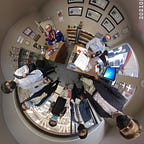A Little Perspective
For decades, societies worldwide have emphasized concerns about diversity in various settings in the workplace, education, and healthcare. However, with numerous attempts and movements to confront diversity, why does discrimination and inequality, especially in the workplace, exist today? Diversity, as defined by Kenneth Gibbs Jr. in the Scientific American, is the “state of being diverse. . . a range of different things” (Gibbs Jr., 2014). This “range” refers to placing people of different genders, cultures, personalities, races, ages, etc., on an equal platform where every individual is given the opportunity for success. Nevertheless, this motive in society has proven to have been successful, yet has also shown concerns when diversity isn’t managed effectively. In the scientific workforce, diversity welcomes the inclusion of new ideas and experiences and people from different backgrounds, cultures, beliefs, and traditions. It acknowledges the ability to approach scientific concerns from various perspectives receiving different ideas and outlooks leading to enhanced discussion and problem-solving and promoting creativity.
Diversity in science is critically important because when performing research and experiments, it sets the foundations for developing new technologies, addressing practical problems, and shaping what is considered fact and fiction in the scientific world. Too much representation of one group can skew the results of a research position and conclusion leading to subconscious biases and even implicit biases favoring one perspective on a concurrent issue. And if these results were to be released to the public, newly taught in our classes, and even written in our textbooks, it sets disadvantaged groups on an unequal platform to demonstrate their representation making it harder for them to succeed. Furthermore, Kenneth Gibbs Jr. depicts that “diversity is critical to excellence” discussing how “when groups of intelligent individuals are working to solve hard problems, the diversity of the problem solvers matters more than their individual ability” (Gibbs Jr., 2014). From this statement, the author highlights how diversity is more significant than the overall quality of who is considering the scientific research and observing the issues are diverse perspectives are integral to achieving it.
The idea of looking at an issue from different viewpoints is critical when tackling various issues as some populations would be more specialized and accustomed to those studies. For instance, an article written by Lyons’, Kacev’s, and Mull’s article evaluated the female choice in multiple paternity and provides a comprehensive analysis when considering drivers of multiple paternity in elasmobranchs. An important factor that was discussed was how significant “consider[ing] multiple paternity from both the female and male-specific perspectives. . . sexual conflict has only been considered through the male lens, possibly because a majority of past literature in this taxon and others has been written by men” (Lyon et al., 2021). From this statement, when observing different forms of anatomy from men and women, it’s possible that implicit biases can influence our interpretations of data affecting the results of the study.
Moreover, Gibbs Jr.’s article further mentions how diversity is significant as without it would “represent a loss of talent” (Gibbs Jr., 2014). He enlightens the imbalances in the racial and ethnic and gender representation among different scientific fields suggesting how, “Thus, the large and persistent underrepresentation of certain social groups from the enterprise represents the loss of talent” (Gibbs Jr., 2014). Further, this would portray that lack of presentation would cause critical contributors to the talent pool. For example, in the lab where I’m currently working, the representation of Hispanic and African American Groups is little to none. Even when discussing with other colleagues in other lab groups, it’s the same issue. Furthermore, when observing the demographics of UC San Diego, the representation is overwhelmed by White or Asian populations. This can be caused by socioeconomic status (education, occupation, and income), however, it still doesn’t adequately provide the necessary distribution of personal experiences, values, and worldviews that arrives from differences in culture and circumstances. This causes critical changes to the talent pool, affecting stereotypes, and potentially influencing results from their findings. Overall, diversity in science is critically important for insurance and safety among all groups around the world. Our goals should be to maintain equality for all populations to possess an equal opportunity to succeed because their perspective is just as important as ours.
In terms of increasing diversity in STEM, the most important factor is awareness. Our society is built under the prioritization of one’s own concerns and issues such as family, education, career, etc. It’s a fair focus, however, everyone can have the ability to distribute some of that time and energy into helping others. Therefore, to enhance awareness, it’s necessary to create a safe environment where students can learn and explore with confidence. Everyone’s perspectives matter and creating an environment that welcomes all different perspectives will create a culture and atmosphere where they can develop their talents in the future and in the workforce. Other methods of awareness can be through movements, social events, or even just talking about it with a few friends. Building a culture of care for all populations is necessary and ultimately will come back and benefit everyone as a whole. Because life isn’t about reaching the top over others, it’s about reaching it with others with a little perspective.
Work Cited
Gibbs Jr., K. (2014, September 10). Diversity in STEM: What it is and why it matters.
Scientific American Blog Network. Retrieved June 2, 2022, from https://blogs.scientificamerican.com/voices/diversity-in-stem-what-it-is-and-why-it-matters/#
Lyons, K., Kacev, D., & Mull, C. G. (2021). An inconvenient tooth: Evaluating female choice in multiple paternity using an evolutionarily and ecologically important vertebrate clade. Molecular Ecology, 30(7), 1574–1593.https://doi.org/10.1111/mec.15844
